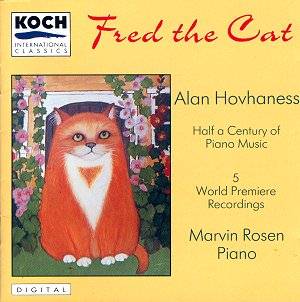Alan HOVHANESS (1911-2000)
Fred the Cat
Piano Music:-
Dance Ghazal Op. 37a (1931 rev 1938)
Slumber Song Op. 52 No. 2 (1938)
Achtamar Op. 64 No. 1 (1948)
Fantasy on an Ossetin Tune Op. 85 No. 6 (1951)
Orbit No. 2 Op. 102 No. 2 (1952)
Mountain Dance No. 2 Op. 144b (1941 rev 1962)
Macedonian Mountain Dance Op. 144 (1938)
Sonata, Mount Ossipee Op. 299 No. 2 (1977)
Sonata, Fred The Cat Op. 301 (1977)
Sonata, Prospect Hill Op. 346 (1980)
Sonata, Mount Chocorua Op. 335 (1980 rev 1982)
 Marvin Rosen (piano) Marvin Rosen (piano)
DDD rec 20 June 1992, Forge Recording Studio, Phoenixville, PA, USA
 KOCH International
Classics 3-7195-2H1
[71.21] KOCH International
Classics 3-7195-2H1
[71.21]
Crotchet AmazonUK
AmazonUS |
 |
Hovhaness's piano music has largely owed its discography to Marvin Rosen.
Rosen's introduction to the composer came through a chance hearing of a broadcast
of the Second Violin Concerto. This must surely have been the 1970s premiere
played by Menuhin who, almost needless to say, did not go on to record it.
Another opportunity lost as in the case of Menuhin's premiere of the Stanley
Bate Violin Concerto. Rosen, after this 'profoundly moving, even spiritual,
experience' took five of the piano sonatas as the basis for his doctoral
thesis. Four sonatas are on this disc.
The water gardens nature of the 1930s Dance Ghazal is close
to Holst's piano music. The theme was used again in Symphony No. 22 City
of Light. A ghazal, by the way, is a form of Persian poem - usually
a love poem. Bantock wrote Four Ghazals of Hafiz for baritone and
orchestra. Hovhaness returned to the Ghazal with two named pieces
in 1963. These appear on the other Koch-Rosen CD as well as on the Arzruni
Hearts of Space collection.
The Slumber Song is more noticeably oriental as is the bipartite
Achtamar (the legendary subject of one of fellow Armenian,
Khachaturian's three operatic songs with orchestra). The bass-pounding tone
and fast ripple replicates the sounds of various instruments: tmpoog, kanoon
and oud. The composer's cat contributed a line to the first segment by walking
across the piano keys.
The Ossetin Fantasy finds Hovhaness in courtly mode - pearly
and vibrant. Orbit 2 was written for the dancer Midi Garth
and its Cage-like approach is declared by the use of a timpani stick which
is applied to the inside of the piano. This piece, reflecting the composer's
fascination with astronomy (remember that Carl Sagan used Hovhaness's orchestral
music in his NBC 'Cosmos' series), would go well with Cage's Interludes
and Sonatas. The brief Mountain Dance is also bass-toned
and explores profound sonorities touched with Scythian savagery. This is
followed by a jazzy and Hungarian-styled Macedonian Dance.
From a period between 1977 and 1982 come the four sonatas. All are brief
apart from Op. 335 which lasts almost half an hour. Mt Ossippee
is in four jewel-short movements, the second and last of which are
of Bachian clarity and 'sewing machine' patterning. This work was inspired
by a ramble through the New Hampshire highlands.
The Sonata that gives the disc its name was written for Jurgen Gothe
whose boundary-oblivious column used to be one of the joys of the 1980s era
Fanfare. In it he would range over rock, garage, and classical striking attitudes
that challenged the readers - well they challenged me! I missed that column.
When Gothe's cat, Fred, died, Gothe commissioned this dignified but heartfelt
work which again dissects the orientally-accented and the hymn-like. The
expressive simple pleasures of Fred the Cat Flies to Heaven
recall sentimental folk art. There is nothing of affectation or
condescension here.
The Prospect Hill sonata (devoid of obvious Oriental inflections)
has the bell-like insistence of Mozart, Scottish vigour and a sense of Holst's
Tyburn Lads in two movements flanking a reverential andante.
After three sonatas lasting well under ten minutes each,
Chocorua, named after another mountain in New Hampshire, embraces
oriental twists and shadings as well as having a much more symphonic spatial
stance. It plays for almost 28 minutes in three movements of which the first
has the sense of an ascension not simply across contours but spiritually
also. The rippling motion of the Jhala is succeeded by a typically
sonorous Hymn to the lake that shares the name of the Mountain.
Virginia France contributes essential background notes. She reminded me that
Hovhaness had been a pupil of Martinu at Tanglewood. I wonder what he made
of the Czech composer's music. I am sure that some the lambent and lucid
qualities so evident in the Fresques and Fourth Symphony must have
influenced Hovhaness.
The piano is closely recorded catching the harmonic pepper as well as the
Bartókian motoric drumming.
If you must have one CD of Hovhaness's piano music this is it. Rosen's
authoritative interpretations are a delight in a world of melodic abnegation.
Rob Barnett

